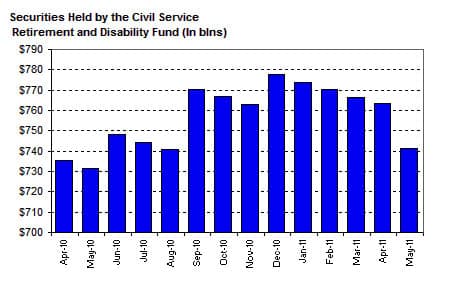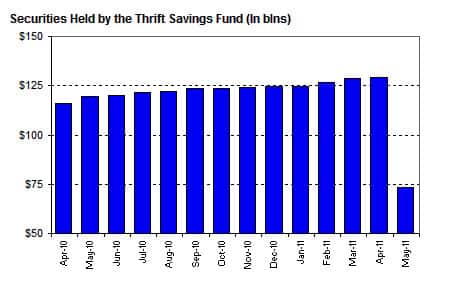The Looters
By Doug Hornig
Lately, every second dispatch out of Washington D.C. has involved the debt ceiling. For anyone who’s been living under a Martian rock for the past two months, the federal government reached the statutory limit of what it’s able to borrow back in mid-May. In other words, without running up further debt, it can’t pay its bills. But the law prohibits the issuance of any more funny paper. Impasse.
This has happened in the past, and it has always resulted in an increase in the debt ceiling. Now we’re bumping our heads against it one more time. Unless that limit is raised, and soon, the "full faith and credit of the U.S. government" will be a thing of the past as the Treasury begins to default on its obligations.
President Obama and the Republican leadership in the House have been at loggerheads over this issue. The GOP wants drastic spending cuts to the federal budget before it agrees to raise the limit; Obama wants some form of tax increases to make the cuts more palatable. Both sides throw out words like "non-negotiable."
‘Round and ’round it goes – with each party accusing the other of holding the American people hostage to its ideological agenda – but where it stops, everyone knows. Some kind of deal will ultimately be struck. The limit will be raised, the government will get the extra money it needs to further bloat its spending programs, the levers of power will be greased, and life will go on. That’s what all involved want. For the most part, the rest is grandstanding for the folks back home.
But do you see the more interesting question here? If not, go back to that first paragraph and reread it. See it now?
Right. The debt limit was reached on May 15. So how come the defaults didn’t begin immediately? Who’s been paying the bills in the meantime?
Did you guess that, some way or other, we have? You’re pretty much correct. If you were reading the newspaper back in May, you might have seen a small reference to a statement from Treasury Secretary Geithner to the effect that he could delay the day of reckoning until August. You probably didn’t see any specifics, but some kind of accounting gimmick was involved, you were led to believe. No biggie. Don’t worry.
In fact, what happened was that Geithner declared a "debt issuance suspension period" (DISP), to be in effect from May 16 to August 2. No new debt would be issued. Ok, that sounds good. But what about the aforementioned bills that would come due in the interim?
Well, as Geithner explained in a letter to congressional leaders, during this period the Treasury "will suspend additional investments of amounts credited to, and redeem a portion of the investments held by, the CSRDF, as authorized by law." And he went on to say the same regarding the "Government Securities Investment Fund [‘G Fund’] of the Federal Employees’ Retirement System."
The CSRDF is the Civil Service Retirement and Disability Fund. The G Fund is part of the Thrift Savings Plan. Though there are some differences in employer vs. employee contributions, both are basically pension plans for civil service employees. And both have basically been looted.
Here’s what happened to the former (figures are for the end of the month):
As you can see, at the end of last year, the CSRDF held over $775 billion in assets. The Office of Personnel Management estimated at that time that the total would swell to $806B by the end of this year. They may have a tough time getting there. Note the $22B drop in May – that’s the DISP at work. And it’s gotten worse since. According to the just-released Monthly Statement of the Public Debt, as of the end of June, the Fund had plunged to $680B. More DISP.
The situation over at the Thrift Savings Fund? Check this out: Around $130B in assets at the end of April shrank to less than $75B by May 31. And it gets worse – the June report shows a meager $27B left in there.
So, prohibited from issuing debt, the government raided – excuse me,borrowed from -people’s retirement funds instead. And they took alot. More than $180 billion. Of course, in Secretary Geithner’s encouraging words: "Each of these actions has been taken in the past by my predecessors during previous debt limit impasses. By law, the CSRDF and G Funds will be made whole once the debt limit is increased."
Perhaps so. But these sorts of shenanigans do not exactly inspire trust in our financial overlords. They suggest desperation. And they also raise some disturbing possibilities.
Consider that while the Treasury lists the CSRDF under "Government Account Series – Intragovernmental Holdings," the G Fund is denoted a "Government Account Series – Held By the Public." That is more or less people’s personal money. One would be forgiven if one thought that, despite Geithner’s historical precedents, it should be off limits to government fingers.
If civil service pension funds can be molested, what about IRAs? Some have suggested that the government is already eyeing our private retirement accounts, to see what might be gotten out of them. Washington created them; it can change the rules any time it wants… to require, say, that a certain portion – or all – be invested in government paper. What a windfall that would be.
In the end, "debt issuance suspension," a term no one will ever remember, could turn out to be the wellspring from which all manner of mischief flows.
[With the U.S. government sure to keep at its "spend and pretend" ways, every investor must find some means of protecting his assets from their predations. The Casey Report focuses on identifying emerging trends on the global scene, making a risk-free, ninety-day trial subscription an invaluable tool. Learn more here.]
Also see: 1995 which explain how deputy assistant secretary Tim Geithner first learned how to circumvent legislative approval during the Tequila Crisis.


The fact that they can use an accounting trick to keep going reminds me of Enron. We all know how badly that ended.